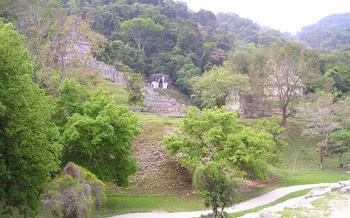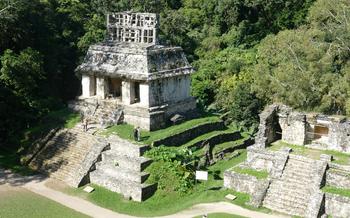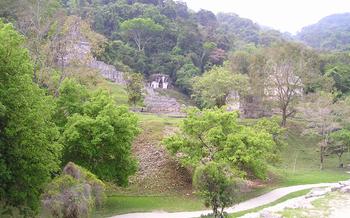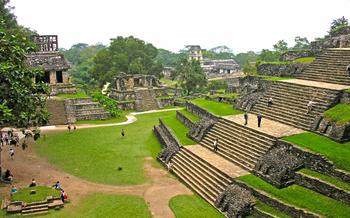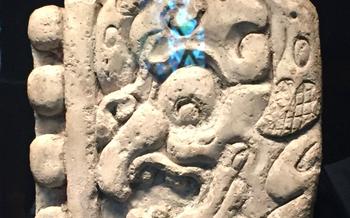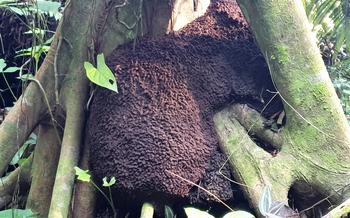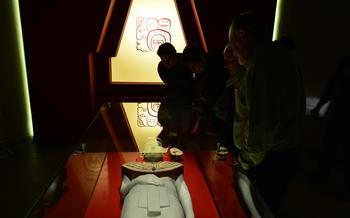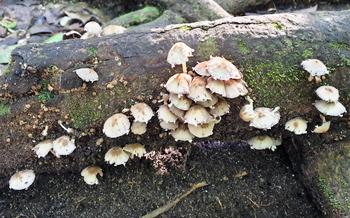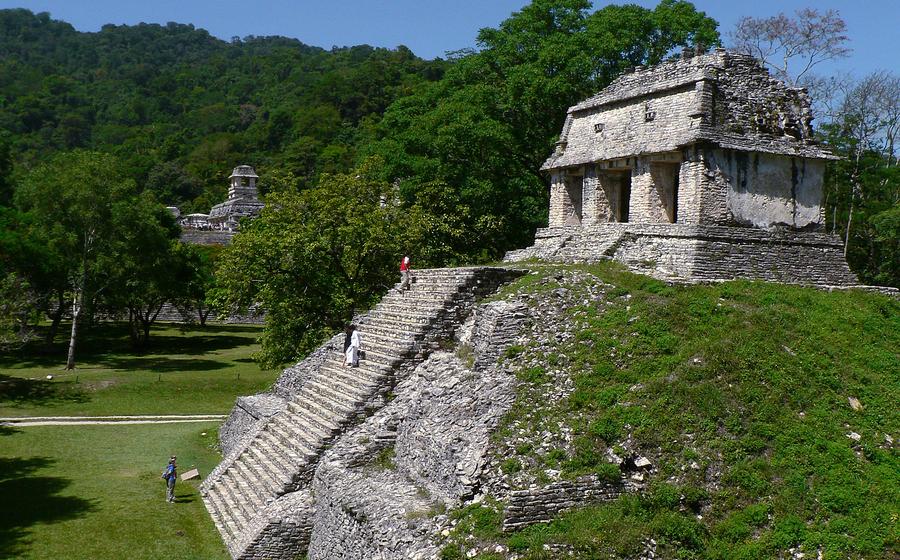
Zona Arqueológica de Chinkultic
- Palenque: A Journey to the Heart of the Maya World
- Unveiling the City of Chinkultic: A Timeless Wonder
- A Path Through Time: The Grand Plaza
- Whispers from the Past: The Temple of Skulls
- In Search of the Sacred: The Temple of the Cross
- A Majestic Stairway to Heaven: The East Acropolis
- Unearthing the Secrets: The Ball Court
- Palaces of Power and Prestige: The South Acropolis
- Echoes of Ancient Rituals: The Stelae and Altars
- The Scribe's Legacy: The Hieroglyphic Stairway
- Lords and Ladies of Chinkultic: The Royal Tombs
- Water and Life: The Reservoirs and Aqueducts
- The Dance of Time: The Calendar and Astronomy
- Decoding the Cosmos: The Planetarium
- Insider Tip: Beyond the Ruins – Exploring Local Culture
Palenque: A Journey to the Heart of the Maya World
In the lush rainforests of Chiapas, Mexico, lies the ancient Maya city of Palenque, a testament to the ingenuity and cultural achievements of this remarkable civilization. Among its many wonders, the Zona Arqueológica de Chinkultic stands out as a hidden gem, offering a glimpse into the past that is both awe-inspiring and thought-provoking.
Palenque's ruins are a testament to the Maya's advanced understanding of architecture, astronomy, and mathematics. The city flourished from the 3rd to the 7th century AD, and its well-preserved structures provide a glimpse into the lives of its inhabitants. Palenque's most famous ruler, K'inich Janaab' Pakal, oversaw a period of great prosperity and expansion, leaving behind a legacy of magnificent temples, palaces, and other structures.
The Zona Arqueológica de Chinkultic is located about 15 miles from Palenque, set amidst a breathtaking landscape of rolling hills and lush vegetation. While less well-known than the main ruins of Palenque, Chinkultic offers a unique and immersive experience for those seeking to delve deeper into the Maya world.
Unveiling the City of Chinkultic: A Timeless Wonder
In the heart of the Lacandon rainforest, nestled amidst towering trees and vibrant wildlife, lies the Zona Arqueológica de Chinkultic, an ancient Maya city that has remained largely untouched by the passage of time. Once a bustling metropolis, Chinkultic is believed to have been inhabited between 300 and 900 AD, reaching its peak during the Late Classic period. While its ruins may not be as grand as those of its more famous counterparts, such as Tikal or Palenque, Chinkultic offers a unique glimpse into the lives and culture of the ancient Maya.
The city's layout follows the typical pattern of Maya urban planning, with a central plaza surrounded by temples, palaces, and other structures. The most notable feature of Chinkultic is its well-preserved architecture, which showcases the Maya's remarkable engineering and artistic skills. The buildings are adorned with intricate carvings, depicting scenes from mythology, history, and everyday life, offering valuable insights into the Maya worldview.
Chinkultic's location deep within the rainforest has contributed to its preservation. The city was abandoned around 900 AD, possibly due to environmental factors or political upheaval. However, its remote location protected it from the ravages of time and subsequent looting, leaving its ruins remarkably intact. Today, Chinkultic stands as a testament to the Maya civilization's enduring legacy, inviting visitors to step back in time and experience the grandeur of this ancient city.
A Path Through Time: The Grand Plaza
The heart of the ancient Maya city of Chinkultic lies in its magnificent Grand Plaza, a vast expanse that served as a stage for religious ceremonies, political gatherings, and bustling marketplaces. As you step into this awe-inspiring space, you'll be greeted by a symphony of stone structures that whisper tales of a civilization that once thrived here.
To your left, the Temple of the Cross stands tall, its intricate carvings and symbolic motifs hinting at the spiritual significance of this sacred space. Across from it, the Temple of the Skulls, with its haunting name and intriguing history, beckons you to uncover its secrets.
A network of intricate pathways weaves through the plaza, inviting you to explore the diverse architectural wonders that surround you. As you wander along these ancient paths, imagine the hustle and bustle of daily life in Chinkultic. Traders haggling over exotic goods, priests performing sacred rituals, and rulers addressing their loyal subjects – the echoes of their voices seem to linger in the air, transporting you back in time.
The Grand Plaza was more than just a physical space; it was the beating heart of Chinkultic, where the city's social, political, and religious life converged. Here, the Maya people gathered to celebrate victories, mourn losses, and pay homage to their gods. It was a place where history unfolded, where traditions were passed down from generation to generation, and where the spirit of Chinkultic thrived.
Whispers from the Past: The Temple of Skulls
Deep within the Zona Arqueológica de Chinkultic lies a structure that has captured the imagination of archaeologists and visitors alike: the Temple of Skulls. This unique edifice stands as a testament to the intricate beliefs and rituals of the ancient Maya civilization.
Its name, derived from the numerous human skulls found within its chambers, hints at a macabre past. These skulls are believed to have been the remains of sacrificial victims or war captives, whose spirits were thought to protect the city and its inhabitants.
The temple's architectural features are both striking and enigmatic. Its façade is adorned with intricate carvings depicting skeletal figures and otherworldly beings, creating a sense of awe and mystery. Inside, the temple's chambers are dimly lit, adding to its eerie ambiance.
The exact purpose of the Temple of Skulls remains a subject of debate among scholars. Some believe it served as a place of human sacrifice, while others suggest it was a mortuary temple or a shrine dedicated to the veneration of the dead.
Whatever its original function, the Temple of Skulls stands as a powerful reminder of the complex and fascinating beliefs of the ancient Maya people. Its haunting presence invites visitors to contemplate the cycle of life and death, and the enduring legacy of a civilization that continues to captivate the world.
In Search of the Sacred: The Temple of the Cross
Deep within the Zona Arqueológica de Chinkultic lies a sacred sanctuary that has captivated the imagination of archaeologists and history enthusiasts alike: the Temple of the Cross. This awe-inspiring monument, perched atop a towering platform, holds immense historical and religious significance for the ancient Maya civilization.
Constructed during the Late Classic period (600-900 AD), the Temple of the Cross served as a pivotal site for spiritual rituals and ceremonies. Its imposing presence, adorned with intricate carvings and reliefs, reflects the profound reverence held by the Maya people for their deities.
One of the temple's most striking features is its elaborate cross-shaped motif, a symbol deeply rooted in Maya cosmology. This motif, consisting of four arms extending from a central point, represents the four cardinal directions and the sacred tree that connects the underworld, the mortal realm, and the heavens.
The interior of the temple reveals a series of well-preserved murals and paintings, offering glimpses into the religious beliefs and practices of the Maya. These artworks depict scenes of rituals, offerings, and interactions with divine beings, providing valuable insights into the spiritual world of this ancient civilization.
The Temple of the Cross stands as a testament to the sophisticated religious system of the Maya, where sacred spaces and symbols played a crucial role in connecting the earthly realm with the divine. Its enduring legacy invites visitors to delve into the depths of Maya spirituality and marvel at the enduring power of faith and devotion.
A Majestic Stairway to Heaven: The East Acropolis
The East Acropolis stands as a majestic testament to the architectural prowess and spiritual beliefs of the ancient Maya. A grand staircase, adorned with intricate carvings and symbolic motifs, ascends to the summit, where terraces and platforms offer breathtaking views of the surrounding landscape. This sacred space held immense significance in Chinkultic's society, serving as a stage for religious rituals, ceremonies, and public gatherings.
The staircase itself is a marvel of engineering, demonstrating the Maya's mastery of construction. Each step represents a journey toward the heavens, connecting the earthly realm with the divine. The terraces, arranged in a hierarchical fashion, served as platforms for temples, palaces, and other structures, each dedicated to specific deities or functions.
The East Acropolis was not merely a physical structure but a sacred space where the Maya sought communion with the divine. The alignment of the staircase with celestial events, such as the solstices and equinoxes, suggests a deep understanding of astronomy and its role in Maya religious beliefs.
As you ascend the staircase, an aura of spirituality envelops you, transporting you back to a time when the Maya performed sacred rituals and ceremonies on these very steps. The East Acropolis embodies the essence of Chinkultic's religious and cultural heritage, inviting you to connect with the ancient Maya's profound spirituality and their reverence for the cosmos.
Unearthing the Secrets: The Ball Court
The ancient Mesoamerican ballgame, known as Pok-ta-Pok, held profound cultural and religious significance in Maya society. At the Zona Arqueológica de Chinkultic, visitors can marvel at the well-preserved ball court, a testament to the athleticism and artistry of the Maya people.
The ball court in Chinkultic is an impressive sight, with its long, narrow playing field flanked by high, sloped walls. The walls are adorned with intricate carvings and bas-reliefs depicting scenes from the ballgame, providing valuable insights into the rules and symbolism of this ancient sport.
The game was played using a solid rubber ball, which was propelled using the hips and forearms. The objective was to keep the ball in play and score points by hitting it through stone hoops mounted on the walls. The game was not only a form of entertainment but also a sacred ritual, often associated with fertility and the agricultural cycle.
The ball court at Chinkultic is a reminder of the Maya's deep connection to their gods and the natural world. It invites visitors to step back in time and imagine the fierce competitions and fervent rituals that once took place within its walls.
Palaces of Power and Prestige: The South Acropolis
The South Acropolis stands as a testament to the power and prestige of Chinkultic's ruling elite. This imposing complex comprises several palaces, each adorned with intricate carvings and architectural details that speak to the artistry and skill of the Maya builders. The palaces served as residences for the city's rulers and their families, as well as administrative and ceremonial centers.
Within these grand structures, the Maya elite conducted their daily affairs, made important decisions, and received visitors and dignitaries. The palaces are adorned with elaborate facades, featuring sculpted figures, glyphs, and intricate geometric designs. These decorative elements not only beautified the buildings but also conveyed important messages about the power and authority of the rulers.
One of the most notable features of the palaces is the presence of large, open courtyards. These courtyards served as gathering places for the elite, where they could hold meetings, conduct rituals, and receive petitioners. The courtyards were also used for entertainment, such as music, dance, and theatrical performances.
The South Acropolis offers a glimpse into the lives of the Maya elite, their power structures, and their daily routines. It is a testament to the sophistication and complexity of Maya civilization, where rulers held immense power and influence, shaping the fate of their people and leaving a lasting legacy in the ancient city of Chinkultic.
Echoes of Ancient Rituals: The Stelae and Altars
Stelae and altars were essential components of Maya religious practices and held profound significance in Chinkultic. These monolithic structures often adorned the main plaza and other sacred spaces within the city. The stelae, or carved stone slabs, typically featured intricate iconography, hieroglyphic texts, and depictions of Maya rulers or deities. These monuments served as historical records, commemorating important events, lineage, and achievements of the city's leaders.
The altars, on the other hand, were used for offerings and rituals. They were often placed in front of stelae or in designated areas within temples and shrines. Offerings made on these altars could include incense, food, precious objects, or even bloodletting. Through these rituals, the Maya sought to communicate with their gods, honor their ancestors, and petition for blessings or protection.
Both stelae and altars played a crucial role in the religious and ceremonial life of Chinkultic. They served as physical manifestations of the city's beliefs, traditions, and connection to the divine realm. By studying these monuments, archaeologists and historians gain valuable insights into the spiritual practices and worldview of the ancient Maya civilization.
The Scribe's Legacy: The Hieroglyphic Stairway
Among the many wonders of Chinkultic, the Hieroglyphic Stairway stands out as a testament to the Maya's mastery of writing and record-keeping. This grand staircase, adorned with intricate carvings and glyphs, narrates the history and lineage of the city's rulers. Each step tells a story, revealing the names, titles, and accomplishments of past kings and queens.
The stairway serves as a window into the minds of the ancient Maya scribes, who meticulously recorded important events, astronomical observations, and religious rituals. The inscriptions provide valuable insights into the political, social, and cultural dynamics of Chinkultic, shedding light on alliances, conquests, and the rich tapestry of Maya life.
As you ascend the Hieroglyphic Stairway, imagine the scribes diligently carving each symbol, preserving the legacy of their civilization for posterity. The stairway is a tangible reminder of the Maya's intellectual prowess and their deep connection to the written word.
Lords and Ladies of Chinkultic: The Royal Tombs
In the heart of the Zona Arqueológica de Chinkultic, hidden beneath layers of earth and time, lie the royal tombs of the ancient Maya rulers. These subterranean chambers, discovered by archaeologists in the late 20th century, offer a glimpse into the lives and power of the Maya elite.
Elaborate burial practices accompanied the Maya rulers in their journey to the afterlife. Their bodies were adorned with intricate jade jewelry, symbolic of their divine status, and accompanied by precious offerings such as ceramic vessels, obsidian blades, and finely crafted figurines. These offerings were believed to sustain the rulers in the next world, providing them with the necessities and luxuries they enjoyed in life.
The royal tombs also reveal the complex social hierarchy of Chinkultic. The tombs of the rulers were larger and more elaborately decorated than those of the common people, reflecting their elevated status in society. The discovery of multiple tombs suggests that Chinkultic was ruled by a dynasty of kings and queens, each leaving their mark on the city's history and culture.
Exploring the royal tombs of Chinkultic is a profound experience, connecting visitors with the lives and legacies of the Maya rulers who once governed this ancient city. These tombs offer a unique glimpse into the power, rituals, and beliefs of a civilization that continues to captivate and inspire us today.
Water and Life: The Reservoirs and Aqueducts
Chinkultic's water management system was a testament to the ingenuity and resourcefulness of the Maya. The city relied on a network of reservoirs and aqueducts to capture, store, and distribute water throughout the city. These structures were essential for sustaining a large population and supporting agricultural activities.
The reservoirs, strategically placed throughout the city, collected rainwater during the rainy season. These reservoirs were interconnected by a series of canals and aqueducts, which allowed water to flow to different parts of the city. The aqueducts were constructed using a combination of stone and mortar, demonstrating the advanced engineering skills of the Maya.
Water played a crucial role in various aspects of life in Chinkultic. It was used for drinking, cooking, bathing, and irrigation. Water was also considered a sacred element, and it played an important role in religious ceremonies and rituals. The reservoirs and aqueducts were not just functional structures but also held cultural and religious significance for the Maya.
Exploring the reservoirs and aqueducts of Chinkultic provides a glimpse into the sophisticated water management system that supported this ancient city. It showcases the Maya's understanding of hydrology and their ability to adapt to their environment.
The Dance of Time: The Calendar and Astronomy
The Maya civilization was renowned for its advanced understanding of astronomy and timekeeping. In Chinkultic, this knowledge was reflected in the intricate calendar system and the alignment of structures with celestial events. The Maya calendar consisted of two cycles: the Haab, a 365-day solar year, and the Tzolkin, a 260-day ritual calendar. These calendars were used to track important dates, religious festivals, and agricultural cycles.
Astronomical observations played a crucial role in Maya daily life. The Maya priests were skilled observers of the night sky, and they used their knowledge to predict astronomical events such as eclipses, solstices, and equinoxes. These events were considered significant omens and were often associated with religious ceremonies and rituals.
The alignment of structures in Chinkultic with celestial events is a testament to the Maya's astronomical expertise. For instance, the main plaza is oriented towards the sunrise on the summer solstice, suggesting a deep connection between the city's layout and the cosmos. This alignment served as a visual reminder of the cyclical nature of time and the importance of celestial events in Maya culture.
Decoding the Cosmos: The Planetarium
Within the Zona Arqueológica de Chinkultic lies a remarkable gem that speaks to the Maya's profound understanding of the cosmos: the planetarium. This ancient structure stands as a testament to their mastery of astronomy and their deep connection to the celestial realm.
The planetarium consists of a circular room with a central column that supports a domed roof. Within this enclosed space, the Maya priests and astronomers conducted observations and studied the movements of the stars, planets, and other celestial bodies. They used this knowledge to create intricate calendars, predict eclipses and solstices, and track the passage of time with remarkable accuracy.
The planetarium served as a celestial observatory, allowing the Maya to decode the secrets of the cosmos and gain insights into the workings of the universe. It was a place where they could connect with the divine and seek guidance from the heavens.
Standing within the planetarium, one can't help but feel a sense of awe and wonder at the ingenuity and wisdom of the ancient Maya. Their ability to harness the power of astronomy and use it to shape their lives and beliefs is a testament to their enduring legacy and the profound connection they shared with the cosmos.
Insider Tip: Beyond the Ruins – Exploring Local Culture
While exploring the Zona Arqueológica de Chinkultic, immerse yourself in the vibrant local culture of Palenque. Visit the vibrant markets to discover traditional Maya crafts, textiles, and delicious local cuisine. Engage with the friendly locals who are eager to share their stories and traditions. Take a guided tour with a knowledgeable local guide who can provide insights into the Maya culture and history. Learn about their customs, beliefs, and the challenges they face in preserving their heritage. Support sustainable tourism initiatives that give back to the community and protect the environment. Your visit to Chinkultic can be more than just a historical journey; it can be an opportunity to connect with the living Maya culture and contribute to its preservation.

